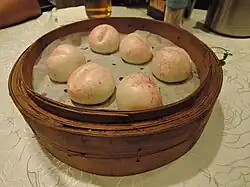Lotus seed bun
 | |
| Type | Sweet bun |
|---|---|
| Place of origin | China |
| Main ingredients | Yeast-based dough, lotus seeds |
| Lotus seed bun | |||||||||||||||||||||||
|---|---|---|---|---|---|---|---|---|---|---|---|---|---|---|---|---|---|---|---|---|---|---|---|
| Traditional Chinese | 蓮蓉包 | ||||||||||||||||||||||
| Simplified Chinese | 莲蓉包 | ||||||||||||||||||||||
| Hanyu Pinyin | lián róng bāo | ||||||||||||||||||||||
| Cantonese Yale | lìhn yùhng bāau | ||||||||||||||||||||||
| |||||||||||||||||||||||
A lotus seed bun (Traditional Chinese: 蓮蓉包;Jyutping: lin⁴ jung⁴ baau¹; Cantonese Yale: lìhnyùhngbāau, pinyin: liánróngbāo) is a Chinese baozi filled with lotus seed paste. It is most commonly served as a form of dim sum.[1]
History
Lotus seed paste is a traditional Chinese cooking ingredient,[2] commonly used as a sweet pastry filling, such as in Lotus seed mooncakes.[3]
Lotus seed paste was used as a filling for sweet buns by Cantonese chefs, and rose to prominence sold as a form of dim sum.[4]
More recently lotus seed buns have become less popular, being sold at fewer dim sum restaurants, often being replaced by other buns with different fillings, such as cocktail buns.[5]

Variations
Longevity peaches, or 壽桃 (pinyin: shòu táo; Jyutping: sau⁶ tou⁴) are a form of lotus seed buns served to celebrate the birthdays of elderly people, symbolizing a good omen of longevity.[6]
Preparation
Lotus seed buns are prepared by steaming a yeast-leavened dough that contains lotus seed paste.[7] Depending on which variation of lotus seed bun is served it can take different shapes, but is traditionally made from the same dough as cha siu baau. When served as a longevity peach, the dough is twisted into a peach shape and given a pink dye to resemble a peach.[5]

See also
References
- ^ Phillips, Carolyn (2016-08-30). The Dim Sum Field Guide: A Taxonomy of Dumplings, Buns, Meats, Sweets, and Other Specialties of the Chinese Teahouse. Clarkson Potter/Ten Speed. ISBN 978-1-60774-956-1.
- ^ GIUCA, L., & Courant Food Editor. (2003). NEW YEAR’S REVELATIONS ; TRADITIONAL CHINESE FOODS CARRY SYMBOLIC WEIGHT DURING YEAR OF THE GOAT CELEBRATION: STATEWIDE Edition. The Hartford Courant.
- ^ Chan, B. (2021). How to bake with tradition; Making a classic mooncake with lotus seed paste and double egg yolk filling takes time and effort. Dim sum chef Tse Sun-fuk shows how it's done. South China Morning Post, 11-.
- ^ Tang, L. la. (2007). Mihn Baau: The localization and consumption of bread in Hong Kong (thesis). Mihn baau: the localization and consumption of bread in Hong Kong. The Chinese University of Hong Kong.
- ^ a b admin (2023-03-21). "<讀食主義>:處處見蓮蓉". 香港中華文化發展聯合會 (in Chinese (Taiwan)). Retrieved 2024-10-25.
- ^ Wong, Adele (2020). Hong Kong Food & Culture. Man Mo Media Limited. ISBN 978-988-77560-3-3.
- ^ Chang, Norma (2001). My Students' Favorite Chinese Recipes. The Travelling Gourmet. p. 28. ISBN 9780961875947. Retrieved May 8, 2012. ISBN 0961875941